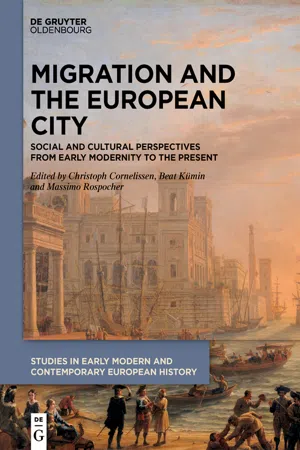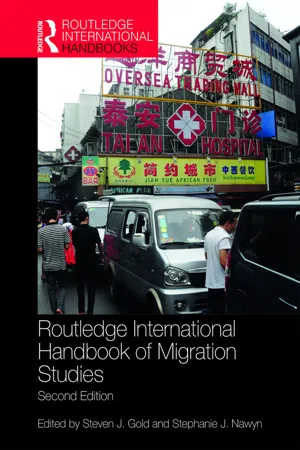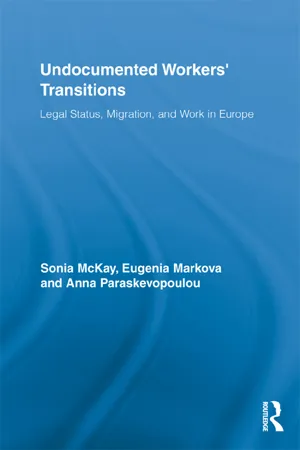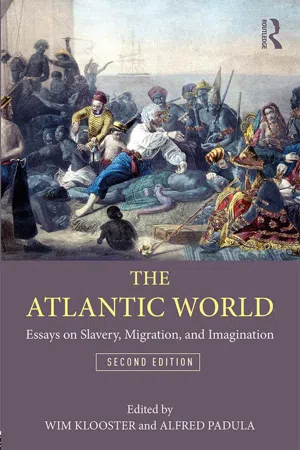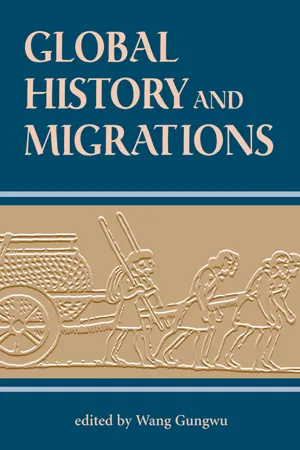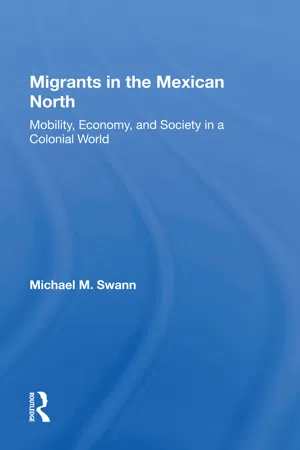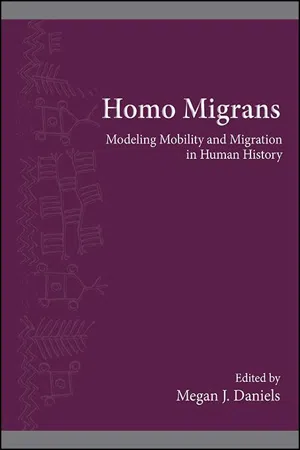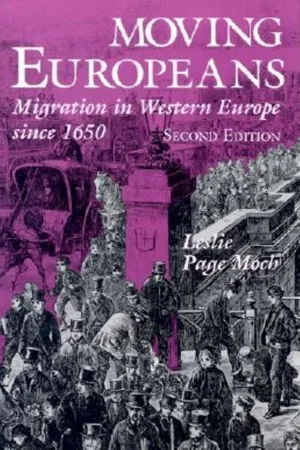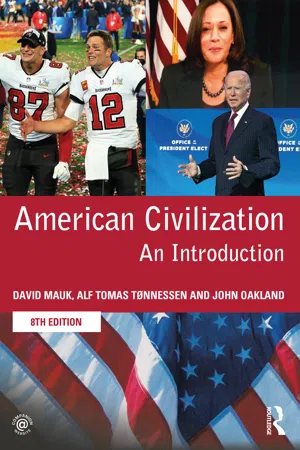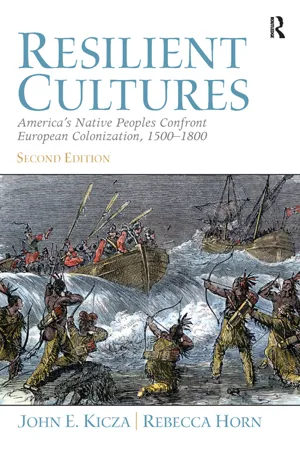History
European Migration to the New World
European migration to the New World refers to the movement of people from Europe to the Americas during the Age of Exploration. This migration had a profound impact on the indigenous populations and led to the establishment of European colonies in the New World. It also facilitated the exchange of goods, ideas, and cultures between Europe and the Americas.
Written by Perlego with AI-assistance
Related key terms
10 Key excerpts on "European Migration to the New World"
- eBook - ePub
Migration and the European City
Social and Cultural Perspectives from Early Modernity to the Present
- Christoph Cornelißen, Beat Kümin, Massimo Rospocher, Christoph Cornelissen, Beat Kümin, Massimo Rospocher(Authors)
- 2022(Publication Date)
- De Gruyter Oldenbourg(Publisher)
Introduction: Migration and the European City
Christoph CornelissenBeat KüminMassimo Rospocher1 Cities and migration in historical perspective
Looking back over the centuries, mobility and migration have always formed an important part of human existence. Given the multiplicity of push/pull factors and shifting constellations, the groups as well as trajectories involved in the movement of people can vary dramatically. It is worth remembering, for example, that regions like Europe – perceived as a preferred destination in the twenty-first century – provided large numbers of emigrants in the past, particularly during the high medieval crusades or global expansion and colonialization between the fifteenth and nineteenth centuries. In numbers, however, the migration of labor was to outweigh these groups by far; roughly, 60 million Europeans crossed the Atlantic to the Americas during the long nineteenth century in search of a new place of work1 .By the close of the Middle Ages, the starting point for this volume, people had plenty of reasons to travel already2 : to advance their learning, scholars – like the humanist Erasmus of Rotterdam – moved from one university to another; in their quest for salvation, pilgrims visited both local shrines as well as the distant holy sites of Rome, Santiago de Compostela, and Jerusalem; to earn a living, agricultural laborers covered great distances in search of seasonal employment at harvest time, mercenaries enlisted for whichever army promised the best prospects, while pedlars carried sought-after commodities from commercial centres into the remotest villages and mountain valleys3 . Once we move into the spiritual upheavals of the early modern period, additional groups included religious refugees fleeing persecution by the confessional Churches emerging out of the European Reformations; in this way, thousands of individuals were forced into temporary or permanent exile across Europe and beyond4 . Alongside religious persecutions, unprecedented numbers of itinerant poor were driven from their homes by socio-economic factors, such as substantial population growth, resource shortages, and worsening climatic conditions5 - eBook - ePub
- Steven J. Gold, Stephanie J. Nawyn, Steven J. Gold, Stephanie J. Nawyn(Authors)
- 2019(Publication Date)
- Routledge(Publisher)
Since independence, Africans have continued to move, both within and outside of the continent. Like migrants in the rest of the world, Africans find themselves threatened with a changing world, economically, politically, and climatically. Though most of the public attention is on Africans trying to migrate to Europe, internal migration affects Africans in much more demographically significant ways, both within individual countries and across national borders. States within the continent have increasingly worked to monitor and regulate the movement of these migrants, with varying degrees of success.ConclusionOver the last several thousand years Africans have used migration as a tool to spread languages, technology, and culture, for religious pilgrimage, to escape violence and oppressive governments, or to find better economic opportunity. While initial migrations were small groups moving small distances over long periods of time, over the past 2,000 years Africans have increasingly migrated longer distances, both due to forced migration and, in later periods, in search of economic opportunity. During the colonial period, European governments attempted to limit migration to particular channels, but since independence, migration within Africa has increased. In recent years, large-scale violence has led to involuntary migration and the creation of over ten million refugees across the continent, while others have attempted to cross the Mediterranean to Europe due to limited opportunity and increasing desertification. Migration has been, and will continue to be, central to the lives of Africans of an ever-changing world.Further readingAlpers, E. A. 2014. The Indian Ocean in World History, New York, Oxford University Press.Arsan, A. 2014. Interlopers of Empire: The Lebanese Diaspora in Colonial French West Africa, New York, Oxford University Press.Austen, R. A. 2010. Trans-Saharan Africa in World History, New York, Oxford University Press.Bellwood, P. S. 2013. First Migrants: Ancient Migration in Global Perspective, Chichester, UK, Wiley Blackwell.Campbell, G. 1989. The East African Slave Trade, 1861–1895: The “Southern” Complex. International Journal of African Historical Studies - eBook - ePub
Undocumented Workers' Transitions
Legal Status, Migration, and Work in Europe
- Sonia McKay, Eugenia Markova, Anna Paraskevopoulou(Authors)
- 2012(Publication Date)
- Routledge(Publisher)
Throughout history, migration has been a feature of human societies, as for most of our history humans led mainly a nomadic life and the search for food or new resources was the primary motivation for finding new and habitable areas. As populations spread and more permanent settlements started to develop, migration continued to take place, often through more complex patterns of warfare and conquests, slavery and colonialism (for example, Greek or Roman in the ancient period), epidemics or religious opposition (such as the Iconoclasts fleeing the Byzantine Empire).Similar reasons for migrating populations can also be found in later periods. So in the middle ages and before the industrial revolution four main causes of migration can be distinguished. First, religion, either in the form of religious persecutions or due to the constitution of new religious sects, became the cause of movements of populations within Europe or the emigration of Europeans to America, but also to other parts of the world. For example, the rise of Protestantism through the reformist movements of Luther and Calvin were embraced as a new religion in some European countries but suppressed in others, depending on the preferences of the monarchs. Thus between the 15th and 17th century, religious refugees such as the Huguenots in France, the Protestant Dutch from the South, and the Jews and Moors of Southern Spain (to name but a few) escaped to countries where Catholicism was not the official religion. Religious migration also took place to areas outside Europe, such as the Purists’ movement to America or the secondary migration of the Huguenots to South Africa.The next three types of migration closely relate to the Mercantilist period (which extends beyond the 17th century) and includes economic migration, colonialism, and slavery. First, this is a period of general changes in Europe with a pronounced effect on economic systems. Political and economic transformations were closely related to ideas that gave rise to the new political landscapes, with the creation of nation states as a predominant form of government unit, together with the concept of national sovereignty. This period is characterised by economic expansion and at the same time by the growing intervention of the state apparatus in the national economy. - eBook - ePub
The Atlantic World
Essays on Slavery, Migration, and Imagination
- Willem Klooster, Alfred Padula, Willem Klooster, Alfred Padula(Authors)
- 2018(Publication Date)
- Routledge(Publisher)
39 While England’s colonies certainly differed from one another, these variations did not evolve in a vacuum. The annual inflow of immigrants constantly renewed European influences in America, and internal migration expanded regional colonial cultures into new areas. The continual movement of British men and women across the Atlantic was not intended to Anglicize the colonies—England had better political and commercial ways to effect this change. Such a development, moreover, was naturally limited by colonists’ encounters with the American environment and its native inhabitants. Yet the ebb and flow of emigrants did foster communications between the New World, the Old World, and the broader Atlantic world that joined them together. The vast expanse of ocean that seemed at first glance to separate men and women in America from their friends and families in England, ultimately became a heavily traversed passage connecting peoples and cultures, colonies and the kingdom.Focus Questions
- What is internal migration and when did it take off?
- How did migration patterns to British America change after 1680?
- Why did the influence of newly arriving immigrants decline in the early eighteenth century?
Notes
1 Marcus Lee Hansen, The Atlantic Migration, 1607–1860 (Cambridge, MA: Harvard University Press, 1940), 3–52.2 Numerous local studies produced in the 1970s and early 1980s posit that English communities were strikingly fluid while colonial communities were remarkably stable and cohesive, especially in their early generations. On early modern English society see Keith Wrightson’s synthesis in English Society, 1580–1680 (New Brunswick: Rutgers University Press, 1982). For reviews of scholarship on seventeenth-century America see John Murrin, “Review Article,” History and Theory , 2 (1972), 226–75; James Henretta, “The Morphology of New England Society,” Journal of Interdisciplinary History , 2 (1971–72), 379–398.3 Bernard Bailyn, “Introduction: Europeans on the Move, 1500–1800,” in Nicholas Canny, ed., Europeans on the Move: Studies on European Migration, 1500–1800 (Oxford: Clarendon Press, 1994), 1–2.4 This chapter considers the voluntary and forced migration of British peoples to North America exclusively. For a comparative discussion of the transatlantic movement of Africans and Europeans see David Eltis, “Free and Coerced Transatlantic Migrations: Some Comparisons,” American Historical Review - eBook - ePub
- Gungwu Wang(Author)
- 2018(Publication Date)
- Routledge(Publisher)
2 Moving Europeans in the Globalizing World: Contemporary Migrations in a Historical-Comparative Perspective (1955–1994 v. 1870–1914) Ewa Morawska and Willfried Spohn The purpose of this chapter is twofold. On the one hand, we illuminate the main mechanisms, forms, and patterns, at macro and micro levels, of post—World War II mass migrations of the Europeans in the context of quickening globalization. On the other hand and simultanously, we compare and contrast those mechanisms, forms, and patterns with those of the earlier high wave of population flows across and beyond the European Continent that occurred at the time of the “densification” of long-distance interconnections in the so-called Atlantic world-system, between 1870 and 1914, so as to identify and elucidate the continuities and discontinuities between these two movements. As a brief synthesis of an extensive and complex subject, our discussion unavoidably simplifies the matters dealt with; we have been careful to formulate the generalizations that, in our judgment, “stand” despite the existence of nonsupportive cases and justified reservations regarding aggregation of nonidentical territorial or social units. 1 Our understanding of the major concepts used in this chapter should be briefly explained before we move on. First, the concept of migration denotes one-way as well as repeated movements across nation-state boundaries or within the multinational community (such as the now-borderless EC) for permanent or shorter- and longer-term sojourns - eBook - ePub
Migrants In The Mexican North
Mobility, Economy And Society In A Colonial World
- Michael M Swann(Author)
- 2021(Publication Date)
- Routledge(Publisher)
17 Internally generated influences such as ecological disturbances and conflicts, changes in communications and transportation, and shifts in urbanization and settlement also accounted for the redistribution of much of New Spain’s population. In short, the causes that gave rise to migration in the colonial period were as varied as the characteristics of those who moved.16 See Mellafe, “Importance of Migration,” 306–309.17 Ibid, 304–306.Narrative historical accounts, combined with systematic analyses of colonial society and demography, describe several fundamental and distinct types of migration that took place in New Spain. First, there was immigration into the viceroyalty from Spain, Europe, and other parts of the Hispanic Empire, as well as from Africa. Second, native population movements occurred on a large scale at the time of conquest and, afterward, in the form of forced labor migration. Third, colonization was an ongoing form of mobility that involved the founding of towns and the establishment of large estates on the settlement frontier. Fourth, bursts of migration in different regions took place as a result of Hispanic-Indian conflict, struggles over landholding, and the interplay of ecological events such as drought, famine, and disease. Fifth, vagabondage developed in most regions as populations were displaced by land-grabbing, local economic changes, and ecological catastrophes. Sixth, dissimilarities between the distribution of labor and the spread of resources gave rise to seasonal patterns of return migration while the slow development of established routes of trade and exchange promoted the circulation of population among linked sets of towns. Lastly, other forms of free migration, particularly those associated with wage labor, were important elements in the late-colonial urbanization of New Spain.The flow of immigrants, particularly Spaniards and other Europeans, into New Spain stands out as the most thoroughly documented18 and most geographically extensive of all the major movements. Efforts to reconstruct Spanish immigration have been described in great detail.19 The works of Konetzke20 and Boyd-Bowman21 clearly demonstrate the broad sweep of the trans-Atlantic movement as well as the individual experiences that unfolded. In general, the flow of Spaniards into Mexico after the sixteenth century was moderate and steady.22 After a slow decline in the 1600s, the numbers increased quickly in the late eighteenth century as the Bourbon economic reforms were enacted and opportunities emerged throughout New Spain.23 Many of the peninsulares migrated from impoverished and overpopulated northern Spain to the northern provinces of Mexico and westward into the developing regions of Sinaloa and Sonora.24 By the end of the colonial period, Spaniards and Europeans were distributed fairly evenly throughout Mexico25 and they displayed a striking uniformity in their occupations, socio-demographic characteristics, and ways-of-life.26 Indeed, as Lockhart has noted, they made up an important element in Mexican society, especially on the periphery of the viceroyalty.27 - eBook - ePub
SUNY series, The Institute for European and Mediterranean Archaeology Distinguished Monograph Series
Modeling Mobility and Migration in Human History
- Megan J. Daniels, Megan J. Daniels(Authors)
- 2022(Publication Date)
- SUNY Press(Publisher)
UN International Migrant Stock 2019. This number is projected to grow in the coming years due to various factors including climate change and conflict (e.g., Laczko and Aghazarm 2009).Humans today are constantly on the move, and we are just as frequently trying to get our minds around what to do about being on the move, or else how to deal with other humans on the move. Yet, while the idea of migration is often framed as an event or, most recently, a crisis of the modern world, we must understand these moments as surges in a much longer continuum of human movement, one that has its roots in our evolution. The recent migrations of people from the Middle East and North Africa into the Mediterranean and Europe, undoubtedly as a result of dire situations only a decade or so old, have been framed as an event or crisis. Yet if we asked how long populations have dispersed around the Mediterranean, Europe, and the Middle East, pushed by war, scarcity, and disaster, and pulled by promises and possibilities of social and political stability and economic abundance, how far back in time would we have to go? This is not to deny the importance of understanding and addressing particular causes and consequences of migration by labeling it as “natural” (Castaneda 2017); but two points need emphasizing from the start: (1) migration is not something peculiar to our age, and (2) it is more our definitions of and attitudes toward migration that have changed in recent times than migratory behavior itself (see Isayev, this volume and 2017:11–12; also Greenblatt 2010; van Dommelen 2014:480). Furthermore, while global movement might seem a product of our modern era of hyper-connection fueled especially by the wide availability of air travel, technology merely amplifies what humans have been doing since we first emerged as a species. To quote Russell King (2007:16), “In a sense, humans are born migrants: our evolution is fundamentally linked to the act of migration, to moving from one place to another and adapting to that environment.” In her recent book, The Next Great Migration (2020), Sonia Shah takes this claim even farther: migration is not merely a human cultural tendency, but a biological imperative of all life on earth, and, in opposition to modern-day framings of migration as some crisis to be averted, it is the - eBook - ePub
Moving Europeans, Second Edition
Migration in Western Europe since 1650
- Leslie Page Moch(Author)
- 2009(Publication Date)
- Indiana University Press(Publisher)
133 Western Europe is implicated both in the tale of internal ethical failure and the more global tale of exploitation, and these are of pointed interest for the history of migration in the twentieth century. The enormous discontinuities and dislocations that came with two world wars do not fit into any social, economic, or demographic framework for migration. The wars and their cruelties intrude into peacetime migration history and explain massive discontinuities. Likewise, colonization and the conflicts inherent in decolonization, key segments of the global narrative of domination and uneven resource distribution, go a long way toward explaining the press of Third World people at the shores and borders of western Europe.The twentieth century marks a profound reversal of human movement between western Europe and the rest of the world. When Europe was a large—and relatively fast-growing—proportion of the human population toward the end of the nineteenth century, its people settled in the Americas, the South Pacific, Asia, and Africa. Especially since 1945, however, the flow of population has been toward Europe. At first, this followed independence for India, the partition of India and Pakistan, the independence of Indonesia, then of sub-Saharan and North African states. Movement in the interior of Europe was also rechanneled as centuries-old West-to-East trends were reversed by displacements after World War II and long-standing East-to-West movements were staunched by state policies during 45 years of Cold War. Throughout the century, however, a somewhat uneven trend to urbanization continued, as European youth gravitated toward city life.134These movements responded to the forces of state and international politics, on the one hand, and to economic and demographic needs, on the other. At the end of the twentieth century, both shifted as European states became wary of outsiders and increasingly tightened entry and citizenship restrictions. (For example, the French state discontinued automatic citizenship for children of Algerians, and Germany tightened its entry and citizenship provisions for Aussiedler - eBook - ePub
American Civilization
An Introduction
- David Mauk, Alf Tomas Tønnessen, John Oakland(Authors)
- 2021(Publication Date)
- Routledge(Publisher)
Between 1776 and the late 1820s, immigration slowed to a trickle. The war for independence and founding of the nation Americanized the colonies’ diverse peoples. Anglo-American culture and time weakened the old ethnic communities. Dutch and German areas of influence remained locally strong, but most ethnic groups assimilated. In the 1820s, Americans and newcomers therefore thought the situation was unprecedented when the second wave gathered strength.A range of factors pushed Europeans from their homelands. Religious persecution drove German Jews to emigrate, and political unrest forced out some European intellectuals and political activists, but economic push factors were decisive for most of the “old” northwestern immigrants. Europe’s population doubled between 1750 and 1850. In Ireland and parts of Germany rural people depended on the potato, which yielded more food per acre than grain. The rapid growth of cities encouraged farmers to switch to large-scale production based on farm machinery, eliminate smallholdings and enclose common lands. With these changes, the growing population could not make a living in the countryside. As early immigrants wrote home about their experiences in the US, the alternative of solving problems by immigrating to places where friends and relatives settled became commonplace and emigration soared.During the 1800s, the industrial revolution and an international trade boom spread from Britain to the Continent and the US, but it reached different regions at different times. If nearby cities offered work, emigration rates were lower. But the population surplus from the countryside was so large that huge numbers of people left anyway. Stage migration (moving first to the city and, after some years, from there to a foreign country) became common. Following changes in the Atlantic labor market, people moved to where the jobs were. Steamships and trains made migration abroad safer, faster and cheaper. “America letters” from family and friends in the US gave a remarkably accurate picture of economic conditions there. During the “old” immigration, 15.5 million made America home. - eBook - ePub
Resilient Cultures
America's Native Peoples Confront European Colonialization 1500-1800
- John Kicza, Rebecca Horn(Authors)
- 2016(Publication Date)
- Routledge(Publisher)
A few European settlers who had married Indian women of high social status brought them to their European homes with the intention of lengthy stays. Pocahontas accompanied her husband, John Rolfe, to England, but soon took ill and died. Some women from the Aztec and Inca nobilities who held title to large estates—and sometimes to labor service—wed Spaniards. While most remained in their homelands, a small number traveled to Spain with their husbands. Some remained there for the rest of their lives, constructing mansions and transferring much of their wealth to their new country of residence. In Spain, they were readily incorporated into the national elite, and their descendants proudly displayed their Indian surnames. The Cano y Montezuma family, for example, circulated in the highest social circles in Mexico and Spain through the end of the colonial period, while retaining the entailed estates it had originally received through the indigenous noble lineage. The family had its origins in the (fourth) marriage of Isabel, the daughter of the emperor Montezuma, with the companion of Cortés, Juan Cano.The migration of people in the other direction, to the Americas, was massive. The vast territory of Spanish America attracted nearly 700,000 immigrants from the home country during the three colonial centuries, an average of around 2,000 a year. Most of these immigrants settled either in Mexico or Peru. Some 523,000 Portuguese came to Brazil, over half of them after 1700. Immigration to New France totaled around 100,000. New Netherland received a mere 20,000. British North America attracted large numbers of settlers, perhaps 750,000 up to the outbreak of the independence movement.In the colonial period, far more Africans came to the Americas as slaves than Europeans as freemen. By 1800, some 7,500,000 Africans had arrived in the New World. The slave trade channeled them in overwhelming numbers to the two primary sugar plantation zones: Brazil (totaling around 2,500,000) and the Caribbean (totaling around 3,700,000). Substantial numbers of Afro-Latin Americas could be found in other settings as well. By 1800, almost 950,000 had arrived in Spanish America, with Mexico, Peru, Venezuela, and Chile among the colonies with substantial African populations. But in many parts of the Americas, African slaves could barely reproduce their numbers, while the Europeans enjoyed very high rates of population increase.The Movement of DiseasesWith no natural resistance to the diseases endemic to the Old World for centuries—smallpox, measles, typhus, malaria, yellow fever, and influenza—the Indians succumbed in overwhelming numbers to the waves of epidemics that accompanied the arrival of Europeans and Africans. Once systematic contact between the two worlds occurred, native populations declined catastrophically over the next 150 years. By that time, many indigenous groups retained merely a twentieth to a tenth of their precontact population, and some peoples had died off completely or other native societies had incorporated their few survivors. After this century-and-a-half of devastation, the surviving native populations began a slow recovery.
Index pages curate the most relevant extracts from our library of academic textbooks. They’ve been created using an in-house natural language model (NLM), each adding context and meaning to key research topics.
